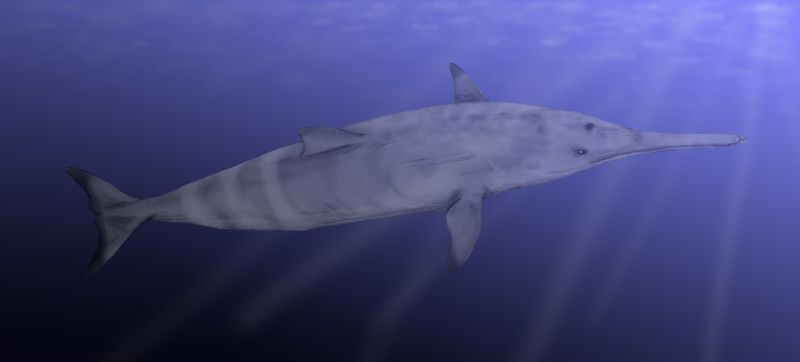- Squalodon
Taxobox
name = "Squalodon"
fossil_range = MiddleOligocene to MiddleMiocene

image_width = 245px
image_caption= Reconstruction of "Squalodon"
regnum =Animal ia
phylum = Chordata
classis =Mammal ia
ordo =Cetacea
subordo =Odontoceti
superfamilia =Squalodontoidea
familia = Squalodontidae
genus = "Squalodon""Squalodon" is an
extinct genus ofwhale s, belonging to the superfamilySqualodontoidea and familySqualodontidae . Named by Grateloup in1840 , it was originally believed to be aniguanodont iddinosaur but has since been reclassified. The name "Squalodon" comes from "Squalus ", a genus of shark. As a result its name means "Squalus tooth."Description
Squalodontids are odontocetes that lived during the early-middle Oligocene into the middle Miocene, about 33 to 14 million years ago. The genus "Squalodon" belongs to the order Odontocete, the toothed whales (Kowinsky, J.). The superfamily Squalodontidae is named after the shark "Squallus" because their cheek teeth look like the teeth of a squallus shark. Squalodontidae consists of four different groups of medium-sized shark toothed whales. They are short snouted shark toothed whales, the "Prosqualodon", the medium-snouted shark toothed whales, the "Phoberodon", and the long-snouted shark toothed whales, the "Squalodon", belonging to the family Squalodontidae.The unique-looking squalodontids were likely distributed throughout the world in warm waters during the Oligocene and Miocene. Squalodontidae went extinct in the middle of the Miocene, leaving no descendants. Hypotheses of why this family lead to extinction have to deal with competition of other groups of dolphins as well as climate change (Fordyce, R.E).
Ancestral and modern features
This superfamily is characterized by both ancestral and modern features. Their teeth are the most evident ancestral feature. At this time in history other toothed whales were evolving simple conical teeth while Squalodontidae retained their primitive dentition that their ancestors (the archaeocetis) had developed (Fordyce, R.E.). Today living odontocetes have little variation in their teeth. Squalodontids teeth are much more complex: they are widely spaced apart; their cheek teeth are triangular and serrated for grasping and cutting. Due to the efficiency of their primitive dentition squalodontids could have a diverse variety of prey (Fordyce, R.E.),(Kowinsky, J.). Another ancestral quality of the Squalodontidae is their necks. Squalodontid necks are more compressed than their ancestors, the Archaeoceti. Compared to toothed whales at that time, the squalodontids were likely more mobile. Paleontologists also believe that the dorsal fins were reduced but larger than that of the ancestors (Kowinsky, J.). Shark toothed whales also possess many modern features. Their crania were well compressed, their rostrums were telescoped outward, and their skulls show proof of the origin of echolocation. (Kowinsky, J.)
Fossil record and classification
One of the first fossils described in scientific literature is that of a specimen of "Squalodon" (Fordyce, R.E.). Fossils of this species are identified mainly by the teeth but also somewhat by their quite complete skull. Most of the fossil record consists of teeth. Some fossils are of fragments of the skull. A complete fossil skull has yet to be discovered. These odontocete fossils have been discovered in Europe, eastern North America, and Argentina. Because tooth fossils are insufficient for species identification, the fossil record only indicates the family (Dooley,A.). The fossils of squalodontids indicate that this species is more closely related to endangered species of dolphins and not to most of the living dolphins today (Fordyce, R.E.). The classification of this genus is not clear. A book by Charles Darwin states that "...."Squalodon", which have been placed by some naturalists in an order by themselves, are considered......to be undoubtedly cetaceans..." (Darwin, C.) Many of the fresh-water dolphins are differentiated phylogenitically very well, while the argument of some of the species has been going on for more than a century. The taxon is characterized during the Oligocene and Miocene in which heterodont teeth are standard amongst the family. Some modern features of the scapula, however, contradict with current phylogenetic relationships. Squalodontids were believed to be the last common ancestor of the odontocetes until 1984. Dr. Muizon came to the conclusion that rather than to any of the living species this family is closer related to the endangered species. Therefore, the ancestry of todays dolphins has little to do with the squalodontids (Fordyce, R.E.).
See also
*Toothed Whales
*Evolution of cetaceans
*Phocodontia References
[http://www.fossilguy.com/articles/calv_squal/squal_stats.htm] [http://www.tolweb.org/Odontoceti/16025] [http://www.otago.ac.nz/geology/features/paleontology/squalodontidae.html] [http://www.calvertmarinemuseum.com/cmmfc/index.html]
* [http://www.thefreedictionary.com/Squalodon The Free Dictionary]
* [http://www.otago.ac.nz/geology/features/paleontology/squalodontidae.html Shark-toothed dolphins (Family Squalodontidae)]
* [http://www.dinoruss.com/de_4/5a93559.htm DinoRuss]
* [http://sn2000.taxonomy.nl/Taxonomicon/TaxonTree.aspx?id=68654 Family †Squalodontidae - Hierarchy - The Taxonomicon]
Wikimedia Foundation. 2010.
